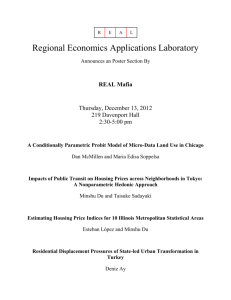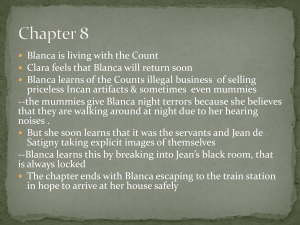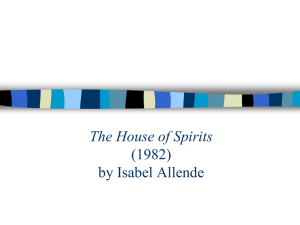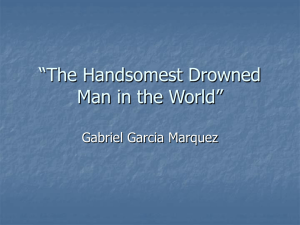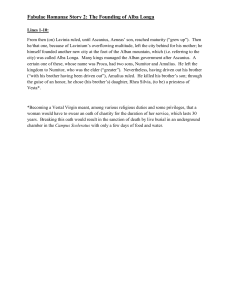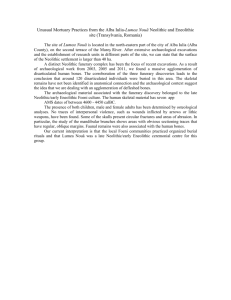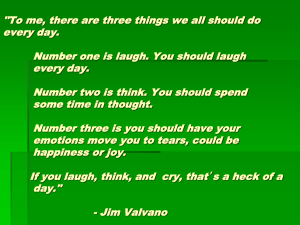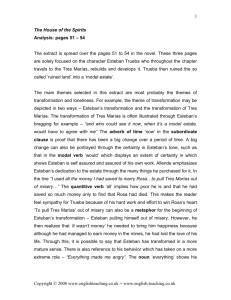The House of the Spirits The Hour of Truth & Epilogue Analysis
advertisement
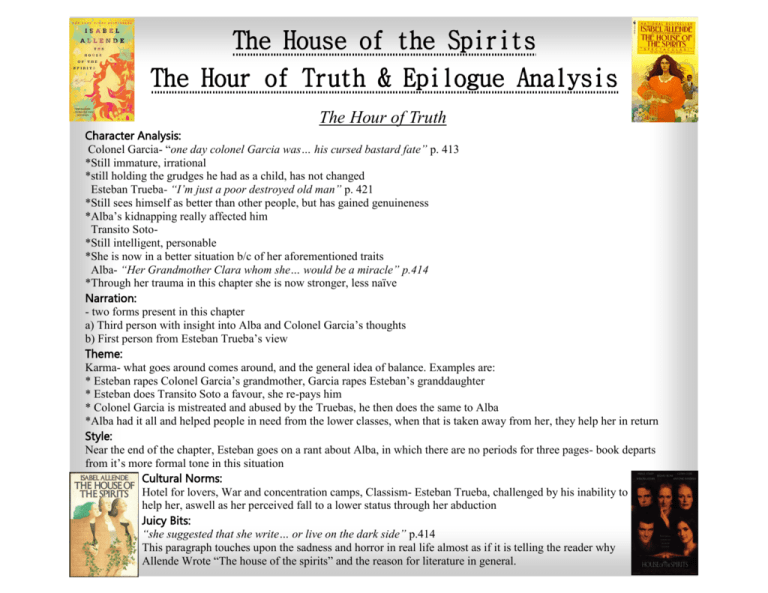
The House of the Spirits The Hour of Truth & Epilogue Analysis The Hour of Truth Character Analysis: Colonel Garcia- “one day colonel Garcia was… his cursed bastard fate” p. 413 *Still immature, irrational *still holding the grudges he had as a child, has not changed Esteban Trueba- “I’m just a poor destroyed old man” p. 421 *Still sees himself as better than other people, but has gained genuineness *Alba’s kidnapping really affected him Transito Soto*Still intelligent, personable *She is now in a better situation b/c of her aforementioned traits Alba- “Her Grandmother Clara whom she… would be a miracle” p.414 *Through her trauma in this chapter she is now stronger, less naïve Narration: - two forms present in this chapter a) Third person with insight into Alba and Colonel Garcia’s thoughts b) First person from Esteban Trueba’s view Theme: Karma- what goes around comes around, and the general idea of balance. Examples are: * Esteban rapes Colonel Garcia’s grandmother, Garcia rapes Esteban’s granddaughter * Esteban does Transito Soto a favour, she re-pays him * Colonel Garcia is mistreated and abused by the Truebas, he then does the same to Alba *Alba had it all and helped people in need from the lower classes, when that is taken away from her, they help her in return Style: Near the end of the chapter, Esteban goes on a rant about Alba, in which there are no periods for three pages- book departs from it’s more formal tone in this situation Cultural Norms: Hotel for lovers, War and concentration camps, Classism- Esteban Trueba, challenged by his inability to help her, aswell as her perceived fall to a lower status through her abduction Juicy Bits: “she suggested that she write… or live on the dark side” p.414 This paragraph touches upon the sadness and horror in real life almost as if it is telling the reader why Allende Wrote “The house of the spirits” and the reason for literature in general. The Epilogue Summary: Begins with the event of Esteban’s death and depicts his brief time with Alba. Describes Alba’s life from the time she leaves the prison and is moved to the concentration camp. Rojas attends to her throughout her time at the prison and helps her when she must leave. Once at the concentration camp, she is reunited with her friend Ana Diaz who, along with the other women, takes care of Alba untill she is taken away. She eventually arrives home after recieving a ride on a horse-drawn cart. She recounts her story to her father and in turn learns Miguel has been helping Esteban find her, and originally suggested seeking the help of Transito Soto. Alba and Esteban arrange for the house to be cleaned and it is beautiful once more. The two then set to the task of writing down all of their stories, and the spirit of Clara appears both to help them and to guide Esteban towards a peaceful death. After Esteban passes away, Alba begins to ponder and her life and the lives of her family members and she lets go of her anger and fear. The story ends with Alba awaiting Miguel, pregnant with either his child or that of one of the men who raped her. Character Analysis: (Alba) She finally comes to terms with everything she’s been through. She recieves help, but also goes through an internal struggle, “The smallest expression of tenderness sent me into a crying fit. I spent the night with my eyes wide open, wrapped in the closeness of so many women, who took turns watching over me and never left me alone.”(page 426, lines 5 – 8). She comes to accpect all the misfortune that has plaugued her family and is less hateful and resentful of everything that has happened to her, “It would be very difficult for me to avenge all those who should be avenged, because my revenge would just be part of the same inexorable rite. I have to break the terrible chain. I want to think my task is life and that my mission is not to prolong hatred but simply to fill these pages while I wait for Miguel, while I bury my grandfather, whose body lies beside me in this room, while I wait for better times to come, while I carry this child in my womb, the daughter of so many rapes or perhaps of Miguel, but above all, my own daughter.”(page 432, lines 26 – 35). Potential Thematic Topics: 1) The path of revenge is mentioned, as are its destructive qualities which Alba decides to not follow. 2) Stories are prevailent throught the whole book and especially in this chapter as Alba writes her journal in the concentration camp, when she reads Claras journals, and when she and Estenban write down their families stories. It adds a sense of finality to the book because you know that the stories of their family won’t be forgotten. Narration: This chapter, being told mostly from Alba’s perspective, differs from the rest of the book that is majorly told by an anonymous narrator and Esteban. This changes the feel of the book as you really get into Alba’s struggle and feel connected to her and the family at the end of the book. Style: Magic realism is used briefly in this chapter,when Clara come to help her husband and grand-daughter, and leads Esteban to the after life. There is repetition used in Alba’s last declaration which adds to the drama of the passage (use of ‘I’). Cultural Norms: In the women’s concentration camp, the inmates challenged the guards who tried to silence their singing and pushed the boundaries of their miniature society. Juicy Bits: Esteban dies peacefully in Clara’s bed
